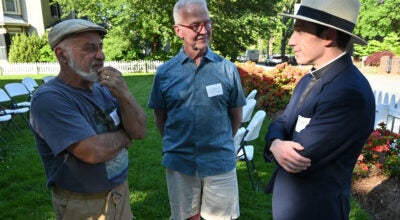Mark Wineka: Coyotes and vultures can be ‘real pains in the butt’
Published 12:00 am Wednesday, October 11, 2017
SALISBURY — Coleman Emerson called me over after a recent civic club meeting and pulled from his pocket a small article he had clipped from the newspaper.
The clipping mentioned that the Rowan Cattlemen’s Association and Piedmont Small Ruminant Association were going to have a coyote and vulture workshop in a few days, and Coleman invited me to attend the $5 dinner program. His treat.
Coleman, always curious and insightful, is a man of the world. He couldn’t resist a reasonably priced program on something as interesting as coyotes and vultures.
The last thing to which Coleman had invited me, besides an occasional lunch, was Joy Gerock’s annual pinto bean gathering. That was, excuse the expression, a blast.
So I trust Coleman’s judgment, plus I told him I couldn’t remember the last time I had used the word “ruminant” in a sentence.
“Even if it’s a total bust,” Coleman said, “we can astonish our friends for having attended. Then again, once they learn we’ve attended, we may not have any friends.”
Amid the gathering of cattle ranchers and small ruminant owners, Coleman and I stuck out like sore thumbs. These friendly folks are a no-nonsense group who do real work for a living and deal with daily challenges such as coyotes and vultures.
I had only written about these critters in the past. I live in a Rowan County subdivision from where I have heard coyotes occasionally yipping and howling at night. On three occasions in the past year, my wife has spotted a coyote skittishly transversing the wood line next to our backyard.
I keep inviting our indoor cats outside, until my wife tells me to shut the back door.
As for vultures, we’ve heard them prancing on top of our high-peaked house in years past. We take them as an ominous, foreboding sign. My wife calls them creepy. Every now and then, we see them roosting at the tops of tall pine trees around our neighborhood, and it always looks like a scene from the Hitchcock movie.
Creepy, it is.
Jessie L. Birckhead, an extension biologist with the Wildlife Management Division of the N.C. Wildlife Resources Commission, presented the program — “Strategies for Problem Coyotes and Vultures.”
I would call Birckhead an expert. She can talk at length about many things such as bats, beavers, vultures and coyotes. But coyotes are by far “the species I spend most of my time with,” she said.
If I can give you the most important takeaway on coyotes, it’s this:
“Coyotes are here,” Birckhead said. “They are here to stay.”
Eradication is not possible. Birckhead said there once was a 40-year federal poisoning program aimed at getting rid of coyotes. It didn’t work. Western states tried everything — shooting them, trapping them, poisoning them — but they all still have coyotes.
Birckhead lumps coyotes in with rats and cockroaches. “I like to be really honest with people,” she said. Coyotes are omnivores, not just carnivores. They seem to be able to live anywhere and eat most anything.
People are a big part of the problem. Coyotes love to live close to us because we create tons of food for them. It could be cats or small ruminants (sheeps and goats, for example) or even a watermelon patch — coyotes aren’t picky.
“They want easy food,” Birckhead said. So she spent a lot of time during her presentation telling the ranchers the best coyote prevention methods and how to make their livestock less vulnerable.
She gave tips on fencing, carcass management, securing animals at night, protecting them when they are calving, establishing livestock guard animals (such as donkeys, alpacas and dogs) and taking lethal control measures.
You can shoot coyotes all day, every day. Birckhead shared a graph that showed N.C. hunters killing more than 47,000 coyotes last year. In addition, some 4,300 coyotes were taken by trapping.
“There are plenty of ways for coyotes to die,” Birckhead said, but they remain prolific because “they’re so, so smart.”
Birckhead said she’s not pro-coyote or anti-coyote. You could sense she respects their survival skills. She added that not every coyote is a problem, “but some can be real pains in the butt.”
The state biologist talked at length, too, about vultures and the differences between turkey vultures and black vultures. The black vultures are really common in the Southeast, and I suspect they are the ones we’ve seen hanging out in our neighborhood in the past.
They are quite social, roosting together on cell towers and in tall trees and abandoned buildings. They have great eyesight, tend to scavenge on large carcasses and are not past exploiting turkey vultures by aggressively moving in and taking over their food sources.
The vultures also are federally protected by the Migratory Bird Treaty Act. Shooting them is a federal offense, and you need a special federal permit for lethal measures. So Birckhead went over the best ways to sort of scare them off.
Vultures don’t like lights and sounds, so Birckhead suggested shining lasers at them and using pyrotechnics such as bangers and screamers.
“Just bug them to death,” she said. “It’s a good first thing to try … but they’ll learn to ignore you after a while.”
Another way to deal with vultures — if you can get high enough — is to hang a stuffed vulture, a vulture carcass or a fake vulture in a prominent area near where they roost.
“Effigies are the most effective solution,” Birckhead said.
Coleman and I left the coyote and vulture program well educated. As we parted in the parking lot, we sort of congratulated ourselves on the successful outing.
Now we can astonish our friends, who no doubt lump us in with rats and cockroaches.
Contact Mark Wineka at 704-797-4263.





